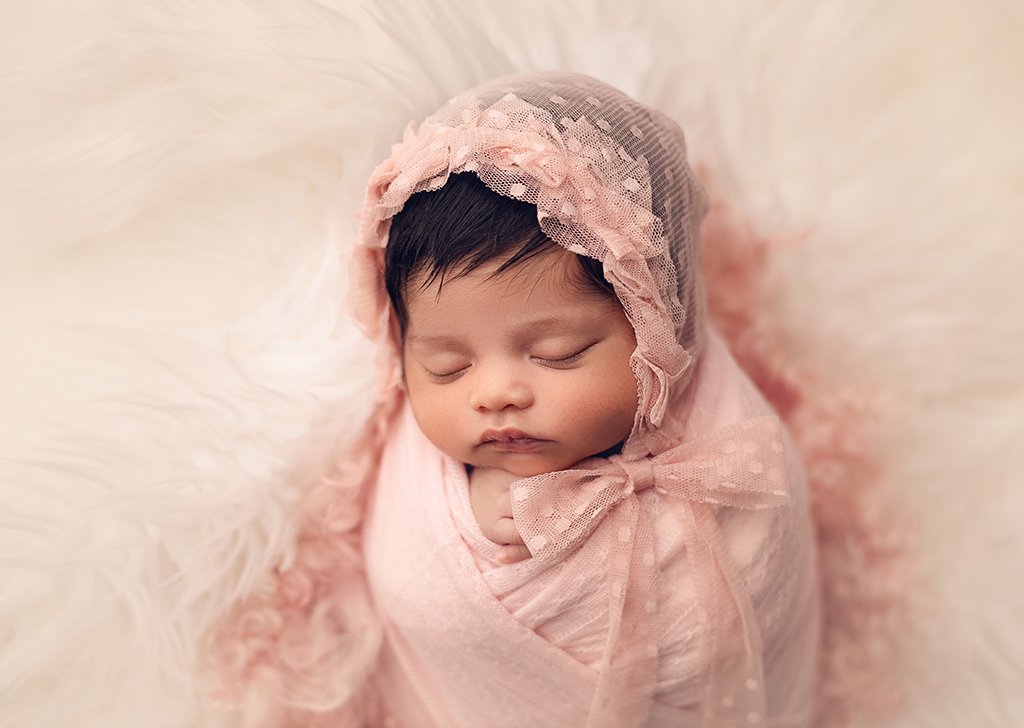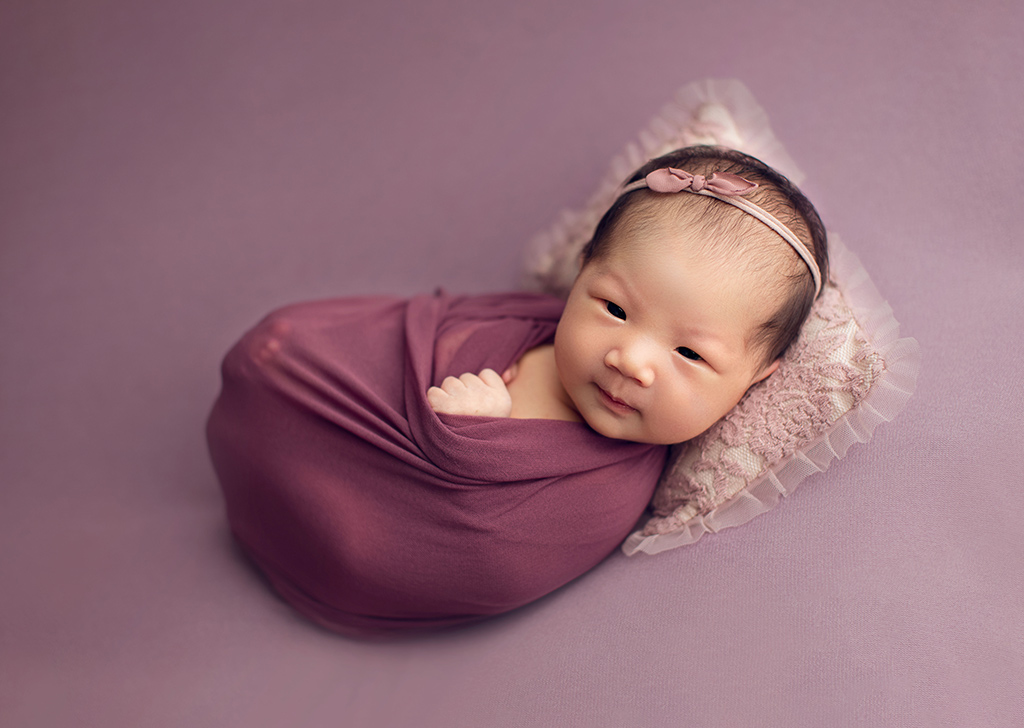Specialising in newborn photography is very niche, and we were curious to know the thought process that goes behind choosing such a specific career path. We spoke with Jiena Lee, owner of Little Sleeping Baby Newborn Photography, who with almost four years of experience tells us her route to becoming a professional newborn photographer.

EOS 5D Mark IV, EF50mm f/1.8 STM, f/2.5, ISO 100, 1/250s, 50mm
Hi Jiena! How did you come to know about newborn photography as a form?
In 2016, I came across a video from an American newborn photographer on my Facebook news feed. In the video, the photographer demonstrated how she prepared for a photoshoot session and posed the adorable baby inside a tiny basket with a beautiful matching headband. I was absolutely fascinated by it, so I decided to learn more about it.

EOS 5D Mark IV, EF50mm f/1.2L USM, f/2, ISO 100, 1/250s, 50mm
What made you want to pursue and specialise in a niche career as a newborn photographer?
I would say that the newborn photography genre wasn’t known or popular in Malaysia four years ago. There are some wedding photographers who provide such services, but the use of lighting props and poses are very different from what I recognise as the ‘western country's style’.
Therefore, I decided to delve into this style of newborn photography through international workshops and classes with premier photographers in the field, as well as professionals who are qualified in teaching safety guidelines for working with newborn babies.

EOS 5D Mark IV, EF50mm f/1.8 STM, f/2.0, ISO 100, 1/250s, 50mm
Since newborns are very delicate, how do you go about handling them as a subject?
If feeding happens during the session, I make sure the baby burps before continuing. Not doing so will make the baby feel uncomfortable as they will feel bloated. Some tips for getting the baby to sleep soundly during the session are to keep the environment comfortably warm, occasionally swaddle the baby and introduce white noise. A sterile environment is also a must, so as good practice, you should give your gear and props a good wipe down too!
Here’s part 1 and part 2 for doing simple camera and lens maintenance!

EOS 5D Mark IV, EF50mm f/1.2L USM, f/2, ISO 100, 1/250s, 50mm
What are some staple poses in newborn photography?
There are so many in the field, and each pose has its unique techniques and requirements. To start, I would suggest the ‘potato pose’ or ‘egg pose’ (example above!) with a basket or beanbag (look them up online for video tutorials). You should also use small pillows or rolled-up towel inserts to prop the baby and adjust their positioning. This pose is really simple and always a charmer for new parents!
In my opinion, having the baby wrapped up in a towel is always easier than adjusting the baby’s limbs for a pose as it requires less skill and props to achieve. However, if you are thinking of attempting the more advanced poses, search online for ‘froggy’, ‘bump up’ or ‘hand on chin’ poses (example below!).
In your professional opinion, what makes good newborn photography?
Less is more. Use simple composition and avoid cluttering the scene. You can introduce props but keep them minimal so the focus is on the baby. I will always strive to produce timeless newborn imagery that the family can treasure forever.

EOS 5D Mark IV, EF50mm f/1.2L USM, f/2, ISO 200, 1/250s, 50mm
What is the one most important Do in newborn photography and why?
Work with a spotter. If you are going to position the newborn in a pose that is not natural, such as hands on the chin (newborns do not have the strength in their limbs to support themselves yet!), always ensure that you have an assistant or parent to act as a spotter. You can guide them on how they can position their hands to prop up the baby safely while staying out of the shot as much as possible. This will keep the baby safe throughout the process while reducing the post-production work to edit out the adult hands.

EOS 5D Mark IV, EF50mm f/1.2L USM, f/1.4, ISO 50, 1/180s, 50mm
What is the one most important Don’t in newborn photography and why?
Do not attempt poses before you attend professional newborn photography courses or workshops. Each pose is designed specifically to keep the baby comfortable, warm, and safe.
Other than that, some of the poses should only be done as composites where two or three images are taken and composited together to create a final photo. Safety is always the first priority for delicate newborn babies.
What are your three tips for perfecting newborn photography?
- Schedule newborn sessions when the baby is between 5 and 14 days old. During this short timeframe, babies will spend most of their days sleeping and curling up as they did in their mother's womb. After two weeks, babies will usually become more active, so it can be a little challenging to keep them in a pose.
- Read the baby’s body language. Some babies can become fussy during the photoshoot session due to hunger, gas in the stomach or regurgitation/reflux. Make sure you deal with that right away so the baby can feel comfortable once again.
- Be confident and reassuring. Sometimes it’s hard to keep parents away from the set, especially when the baby starts crying. We must make parents feel comfortable and reassure them that their newborn is in safe hands when in front of your lens. You can talk to them about family life, how they came up with the baby’s name and future plans etc.
 EOS 5D Mark IV, EF50mm f/1.8 STM, f/2.8, ISO 100, 1/180s, 50mm
EOS 5D Mark IV, EF50mm f/1.8 STM, f/2.8, ISO 100, 1/180s, 50mm
In terms of lighting, how do you utilise flash in newborn photography?
When it comes to setting the lights for newborn photography, the flash needs to be set on low power so you can shoot at a wider aperture without overexposing your image. This allows you to achieve a beautiful gradient blur, placing the focus on the baby itself. I will always look out for how the light falls on the baby and reposition it to be as flattering as possible. In my experience, I love using one light as I can achieve beautiful shadows and definition on tiny faces.
Try to use a diffuser as well. This will soften the harsh lighting to create a more delicate and eye-pleasing quality to the image.
Learn to DIY your photography diffuser here!
For similar articles:
Photography Insider: Portraits of Infants and Newborns
4 Ways to Create Better Baby Photos
5 Ways to Photograph Your Baby from a New Parent’s Perspective

































